I was sitting on my mare Jazzie the other day and thinking about how to present the vast amount of material there is for the Mounted Body Balance™ – In the Saddle classes. Many people ask, well why would I do that if I’m taking a riding lesson? I get a massage regularly, why would I do this?
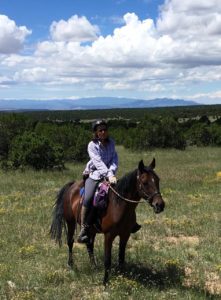
Well, a riding lesson focuses on you in the saddle, in the most efficient posture to get your horse to do what you would like her to do. It may involve some horse management skills. A good lesson will also work on you psychologically – what you’re bringing to the relationship that may or may not be helpful. A massage is great, but it doesn’t ask you to engage with each part of your body and address how it relates to the animal’s body when you’re in the saddle. Further, it allows you to fall asleep, which is not advisable while in the saddle!
Mounted Body Balance™ is an integrated, wholistic, non-force approach of horse and rider that puts us in touch with our senses. When riding we are connecting spine to spine with the horse. Our spine meets the horse’s at one critical point, where our sit bones and tailbone meet the thoracics of the horse. In bodywork for both horse and rider, we are looking at what is available in each body, and working with enhancing that availability for greater comfort and ease. We can also use that strength that we find in one body to help the other body in that same or another area that may not be as available.
For example, when my neck is tight, perhaps instead of directly working with neck rotations on me, I can look at my mare’s neck and see if she has any fill or hardness there. Then I can ask my mare to do side bends and release her neck while I’m on her back. As it turns out, this movement can release the tension in my own neck.
Jazzie has tension along her thoracics. While thinking about my upcoming class, I sat in 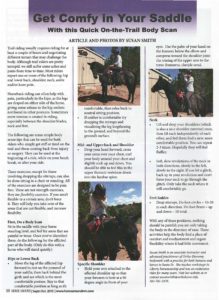 the saddle with the awareness that I am sitting on her mid-thoracics, and I did an technique we call in Ortho-Bionomy©, “disc-fluffing.” (See illustrations in the article). Drop your head forward and pull shoulders forward and cross your arms across your chest. Then press down on and rock your shoulders in this position. This released my thoracic spine. After we did this exercise on me, Jazzie moved forward more boldly. I noticed the flow of her spine underneath me and the rhythm of her ribcage was more forward as well.
the saddle with the awareness that I am sitting on her mid-thoracics, and I did an technique we call in Ortho-Bionomy©, “disc-fluffing.” (See illustrations in the article). Drop your head forward and pull shoulders forward and cross your arms across your chest. Then press down on and rock your shoulders in this position. This released my thoracic spine. After we did this exercise on me, Jazzie moved forward more boldly. I noticed the flow of her spine underneath me and the rhythm of her ribcage was more forward as well.
In the saddle, I can reach for the parts of the horse that are accessible. I can work with her sacrum by reaching behind me and feel its preferred position. My touch is always gentle. I can touch my own sternum and reach down and touch hers as well, and ask the question, are our sternums balanced? With a bigger horse, you may have to dismount to access certain parts of the body effectively.
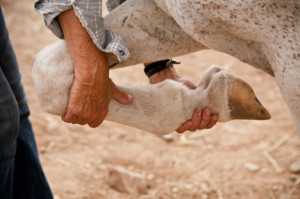 All of us – horse and human – hold tension in our bodies and we also have areas that just don’t speak. We have places that don’t work as well as others. My right leg can get funky in the hip socket, for example. I could sit up there and worry about what a terrible rider I am and I shouldn’t ride because I’m not always symmetrical and blah blah blah, but if I focus on all the dysfunction, then I am missing what my body can do, and how it can support the areas that aren’t working quite so well. My horse has stuff going on in her hips also. I focus on the healing available in her body. And guess what? Even though she has that stuff, she is a beautiful mover. I sit on her, and I feel each part of me and her, and focus on the parts that work really well while holding an awareness of what I’d like to have shift.
All of us – horse and human – hold tension in our bodies and we also have areas that just don’t speak. We have places that don’t work as well as others. My right leg can get funky in the hip socket, for example. I could sit up there and worry about what a terrible rider I am and I shouldn’t ride because I’m not always symmetrical and blah blah blah, but if I focus on all the dysfunction, then I am missing what my body can do, and how it can support the areas that aren’t working quite so well. My horse has stuff going on in her hips also. I focus on the healing available in her body. And guess what? Even though she has that stuff, she is a beautiful mover. I sit on her, and I feel each part of me and her, and focus on the parts that work really well while holding an awareness of what I’d like to have shift.
When I do that, she comes up to meet me, and she will travel beautifully to support my not-so-perfect-body in a way that works for both of us, without restrictive compensation. It helps my body feel better too.
When the horse knows he or she can influence your body for the greater good, he or she will seek that.
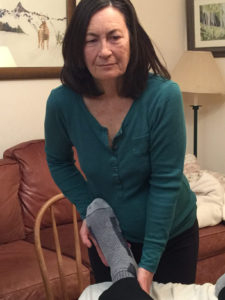 With Ortho-Bionomy© for both horse and rider, we can learn what is holding up the bus. Riding instructors have wonderful ways of encouraging the horse forward, ways for riders’ to hold their legs so that the legs are not being counterproductive for the horse, or to sit correctly so as not to impede the horse’s movement – all of that has to do with the anatomy and the relationship of the two bodies working in sync, or not.
With Ortho-Bionomy© for both horse and rider, we can learn what is holding up the bus. Riding instructors have wonderful ways of encouraging the horse forward, ways for riders’ to hold their legs so that the legs are not being counterproductive for the horse, or to sit correctly so as not to impede the horse’s movement – all of that has to do with the anatomy and the relationship of the two bodies working in sync, or not.
We are often trying to solve certain problems: spooky horse, horse not moving forward, going too fast, short-strided, unbalanced, throwing its head, bucking, anxiety. These problems can be addressed through this form of bodywork.
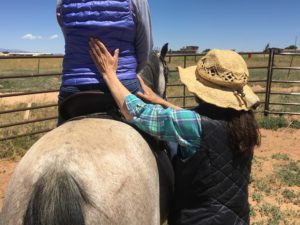
Many riders hold tension in their upper thoracics while riding. In fact, more experienced riders often have more tension in that region. How does this translate to the horse? If the horse is dealing with tension in the lumbar but has great strength in his own thoracics, we can work with the horse’s thoracics to help the rider’s. When he can loosen up in that region and flow better – ribs as well – so can his rider.
The horse with lumbar trouble often won’t move forward freely. If we open up the spine, and check the rider’s engagement with the spine, then the horse can move forward more easily. We may also need to check saddle fit with both thoracic and lumbar pain, for both horse and rider.
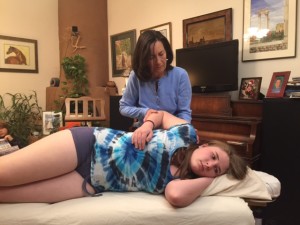 Certainly, work can be done on some of these issues independently of the horse/rider relationship, and I do that in many cases where a person may need individual table work ahead of a horse/rider session, or the horse needs to receive an entire session on his own. If someone has major back trouble, I’m going to work on that, and same with the horse. But once the bodies are free of great inhibition, we can bring them together and see where they can strengthen and enhance each other, and bring space into the relationship that may have been restricted before.
Certainly, work can be done on some of these issues independently of the horse/rider relationship, and I do that in many cases where a person may need individual table work ahead of a horse/rider session, or the horse needs to receive an entire session on his own. If someone has major back trouble, I’m going to work on that, and same with the horse. But once the bodies are free of great inhibition, we can bring them together and see where they can strengthen and enhance each other, and bring space into the relationship that may have been restricted before.
Simple and very regular preparatory techniques that people do to prepare to ride are great 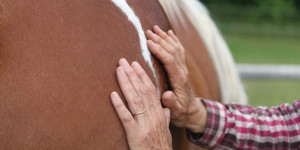 ways of beginning this work. While grooming your horse you can feel along the spine for any irregularities. If you don’t know anatomy, it’s helpful to get a simple equine anatomy book – and a human one while you’re at it! Learn where the bones are. Everything else is related to or attached to the bones in some way, so it’s a great place to start.
ways of beginning this work. While grooming your horse you can feel along the spine for any irregularities. If you don’t know anatomy, it’s helpful to get a simple equine anatomy book – and a human one while you’re at it! Learn where the bones are. Everything else is related to or attached to the bones in some way, so it’s a great place to start.
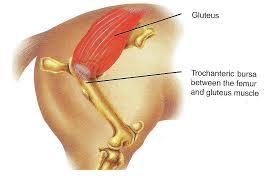
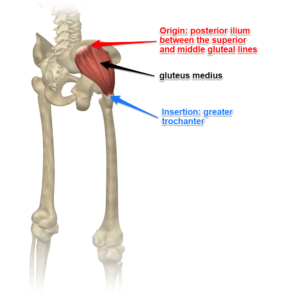
While this may seem elementary, walk your horse out to check his or her gait. Then check your tack when you tack up. While I was endurance riding, the care of the horse was a high priority. I would trot out my horse the morning of the ride before tacking up to make sure he was going well. I would check all my tack before leaving for the ride and the night before the ride. These are good habits to get into even if you’re just going out for a short ride.
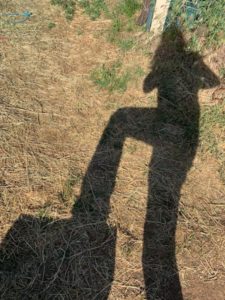 After that I may do a little bit of bodywork on areas I see are not working so well on my horse, and stretch out myself. You can apply your own exercises, such as qi gong, yoga, Feldenkrais, etc. and in Ortho-Bionomy© we have a lot of self-care exercises for people and ones you can do for your horse. Some of them I have adapted to use in the saddle as well.
After that I may do a little bit of bodywork on areas I see are not working so well on my horse, and stretch out myself. You can apply your own exercises, such as qi gong, yoga, Feldenkrais, etc. and in Ortho-Bionomy© we have a lot of self-care exercises for people and ones you can do for your horse. Some of them I have adapted to use in the saddle as well.
This work evolves, so that after awhile you may find you no longer have that trouble with your right knee, for example, and the horse is no longer stiff while crossing over behind to the left, but some other issue has shown itself and so you’ll need to adapt your program to those changes.
I teach this to people so that they can begin to sense the changes themselves. I can show you how to do many things, but then it’s up to you to figure out when to use them and when you may need to try something else. Figuring this out is a lifelong process, although sometimes we’re lucky enough to have some quick fixes. At the same time, you get better at recognizing areas of strength and how to palpate tissue. This approach can be integrated into your riding lessons, performance or trail riding activity and your more sedentary horse work.
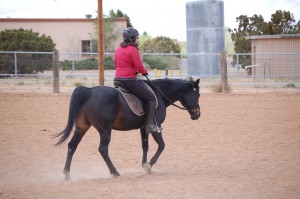 Much thought has been given over centuries to how to ride efficiently and so as to bring out the best in the horse and rider. With the Mounted Body Balance™ approach, an older horse can move better than he or she ever has and so can her rider. Life isn’t static so we can’t guarantee that any of us are not going to have some physical challenges, but there is a lot we can solve and make more comfortable with this type of work. A horse may be able to help you with your body issues without impairing his/her own stride or balance. Of course, aging will limit what you can do but why not try to do what you love comfortably for as long as you can? As a physical therapist friend of mine says, “I’m here to help you be able to do what you love for longer.”
Much thought has been given over centuries to how to ride efficiently and so as to bring out the best in the horse and rider. With the Mounted Body Balance™ approach, an older horse can move better than he or she ever has and so can her rider. Life isn’t static so we can’t guarantee that any of us are not going to have some physical challenges, but there is a lot we can solve and make more comfortable with this type of work. A horse may be able to help you with your body issues without impairing his/her own stride or balance. Of course, aging will limit what you can do but why not try to do what you love comfortably for as long as you can? As a physical therapist friend of mine says, “I’m here to help you be able to do what you love for longer.”
I take her words to heart. When we travel down the trail, I can feel Jazzie’s rhythmic strides, I can feel where my body may not be quite right and make the adjustments and I can feel her shift to accommodate or make that easier for me. Our senses are alive as our bodies connect, as we trot along a well-known path, with deepening knowledge of ourselves – together.
***********
Contact me for private sessions. info@susansmithsantafe.com or through the website.
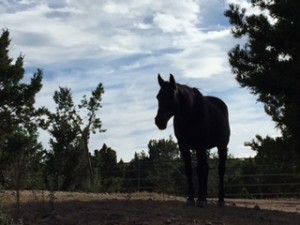 Horse health is such a broad topic, it cannot be limited to what we do in terms of providing hands-on bodywork, or diet or exercise. It also includes emotional, psychological and psychic health, activities to create communication and increase curiosity and the way we ride.
Horse health is such a broad topic, it cannot be limited to what we do in terms of providing hands-on bodywork, or diet or exercise. It also includes emotional, psychological and psychic health, activities to create communication and increase curiosity and the way we ride.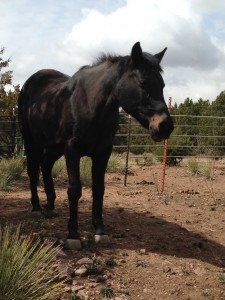 In February, I conducted a Q&A session where one of the questions was about a horse who had stopped eating, and discussing what to do to get the horse eating again. The practitioner with the issue said the horse had just lost his owner and regular stablemates due to death. He had been moved to a new barn with new horses and people.
In February, I conducted a Q&A session where one of the questions was about a horse who had stopped eating, and discussing what to do to get the horse eating again. The practitioner with the issue said the horse had just lost his owner and regular stablemates due to death. He had been moved to a new barn with new horses and people.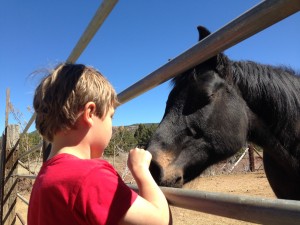 The horse needed a bridge to his new life, where there are very good things available. He just can’t reach for them right now. A horse in this state can go unnoticed in traditional circumstances where people will focus on the lack of appetite but not think about or know how to address the grief.
The horse needed a bridge to his new life, where there are very good things available. He just can’t reach for them right now. A horse in this state can go unnoticed in traditional circumstances where people will focus on the lack of appetite but not think about or know how to address the grief.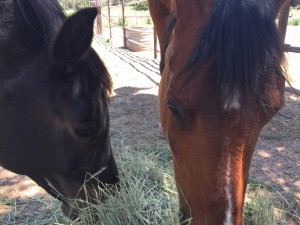 shun connection, though bodywork, a simple laying on of hands, could be very helpful and give valuable information too. Grief makes the body tight and dry, flaky, unresponsive. To loosen up those areas – particularly around the heart – would help the horse feel better in himself, and lo and behold, he may eat.
shun connection, though bodywork, a simple laying on of hands, could be very helpful and give valuable information too. Grief makes the body tight and dry, flaky, unresponsive. To loosen up those areas – particularly around the heart – would help the horse feel better in himself, and lo and behold, he may eat.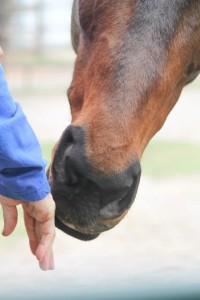 more devastating.
more devastating.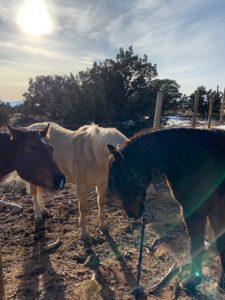 Make sure the horse has companions. Not all horses grieve the same way. Some are sad but they are more able to go through their days as they have a more developed understanding of their stablemate or owners’ passing. That understanding can be supportive to the grieving horse.
Make sure the horse has companions. Not all horses grieve the same way. Some are sad but they are more able to go through their days as they have a more developed understanding of their stablemate or owners’ passing. That understanding can be supportive to the grieving horse.


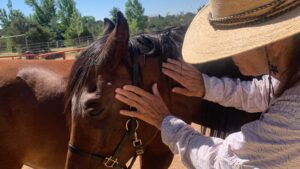 It’s very common for horses to be afraid of bodywork, especially if they have received fear-based training or a number of unpleasant veterinary procedures. Of course, veterinary procedures and surgeries are often non-negotiable. When I have a procedure personally, I can only imagine what that feels like to the horse who doesn’t understand why it’s being done to him or her.
It’s very common for horses to be afraid of bodywork, especially if they have received fear-based training or a number of unpleasant veterinary procedures. Of course, veterinary procedures and surgeries are often non-negotiable. When I have a procedure personally, I can only imagine what that feels like to the horse who doesn’t understand why it’s being done to him or her.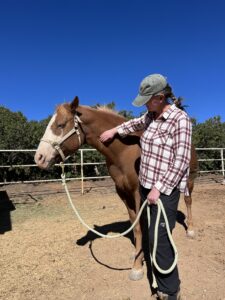
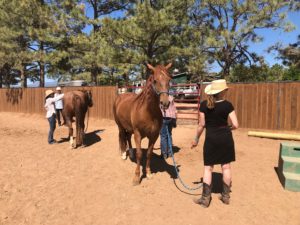 If your horse is continually miserable or reactive during a visit from any practitioner, it may be worthwhile to re-evaluate that professional relationship.
If your horse is continually miserable or reactive during a visit from any practitioner, it may be worthwhile to re-evaluate that professional relationship.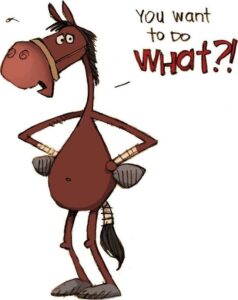 Sometimes I find that the owner isn’t aware of what other professionals are doing with their horses.
Sometimes I find that the owner isn’t aware of what other professionals are doing with their horses.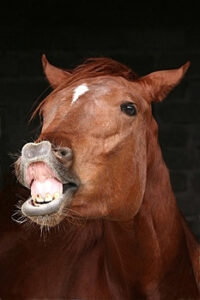
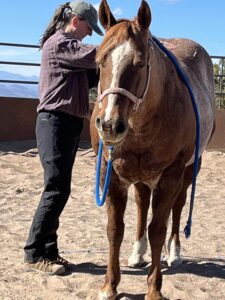
 Over the winter, I feel challenged to provide quality time with my horses. I want to make sure they don’t get bored and prone to injury. I also want to maintain my connection with them.
Over the winter, I feel challenged to provide quality time with my horses. I want to make sure they don’t get bored and prone to injury. I also want to maintain my connection with them.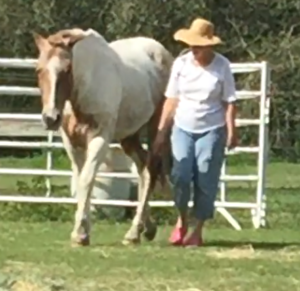 The person who asked about behavioral enrichment realized she had to get very creative. Yes! Exactly right! There are liberty exercises that can be done in muddy footing, which she and her mare had remembered from classes they took with me.
The person who asked about behavioral enrichment realized she had to get very creative. Yes! Exactly right! There are liberty exercises that can be done in muddy footing, which she and her mare had remembered from classes they took with me.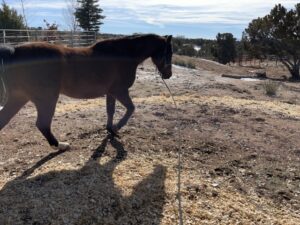 lateral work along the fence on good days. If there is any pattern at all during winter, it is snow plus cold, then sun and mud then a couple of days of dry ground so you can work.
lateral work along the fence on good days. If there is any pattern at all during winter, it is snow plus cold, then sun and mud then a couple of days of dry ground so you can work. A gelding I worked with years ago was going through a patch of being unridden and the owner was wondering what to do with him because he had become dull and uninterested in activity. We worked with playing the drum which perked him up. He loved the deep sound of it. This of course, did not work all the time, as he wanted to know, what next? But it piqued his curiosity so that he could go on to other liberty activities and groundwork, connecting more fully with his owner.
A gelding I worked with years ago was going through a patch of being unridden and the owner was wondering what to do with him because he had become dull and uninterested in activity. We worked with playing the drum which perked him up. He loved the deep sound of it. This of course, did not work all the time, as he wanted to know, what next? But it piqued his curiosity so that he could go on to other liberty activities and groundwork, connecting more fully with his owner.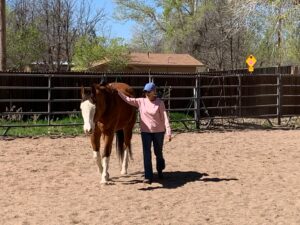
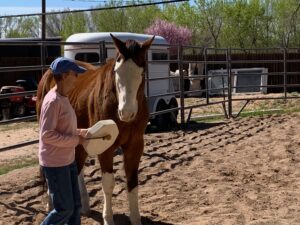 This type of engagement carries over, increases our mutual enjoyment of one another, so that when we actual do “work” again, there is more curiosity, engagement, a feeling of anticipation of what is to come.
This type of engagement carries over, increases our mutual enjoyment of one another, so that when we actual do “work” again, there is more curiosity, engagement, a feeling of anticipation of what is to come.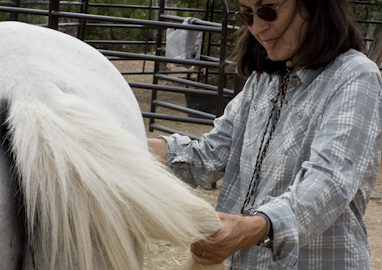
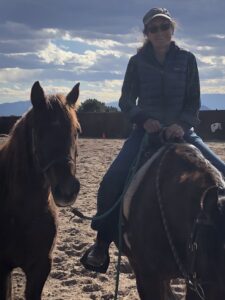 Years ago, when I was riding endurance, many rider/horse teams would head to El Paso during the winter months to ride. Horses had not had much riding time in the colder climates so one had to be careful as they traveled in the deep desert sand. Often the injuries that went unnoticed from the winter riding would appear in the spring.
Years ago, when I was riding endurance, many rider/horse teams would head to El Paso during the winter months to ride. Horses had not had much riding time in the colder climates so one had to be careful as they traveled in the deep desert sand. Often the injuries that went unnoticed from the winter riding would appear in the spring.
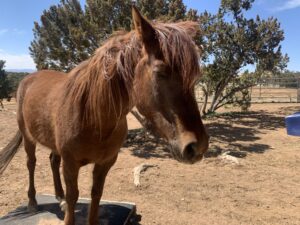 ve around freely is different than the measured, focused exercise we ask of a horse in daily work. Both are very important.
ve around freely is different than the measured, focused exercise we ask of a horse in daily work. Both are very important.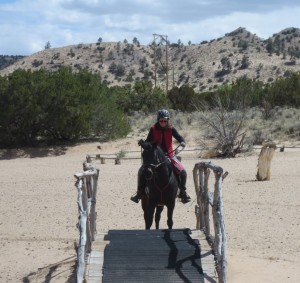 Walking on different types of terrain for horses who can manage it is vital.
Walking on different types of terrain for horses who can manage it is vital. comfortable being ridden anymore. He’s now 26. He enjoys walks and arena activities. He is also teaching our young mare Red to be more curious than she already is. I think this is an excellent way for him to spend his golden years.
comfortable being ridden anymore. He’s now 26. He enjoys walks and arena activities. He is also teaching our young mare Red to be more curious than she already is. I think this is an excellent way for him to spend his golden years.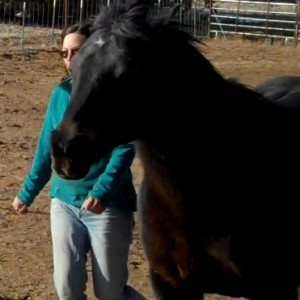
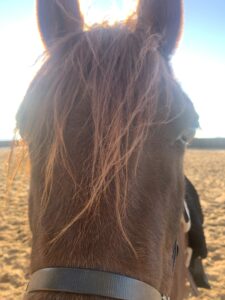
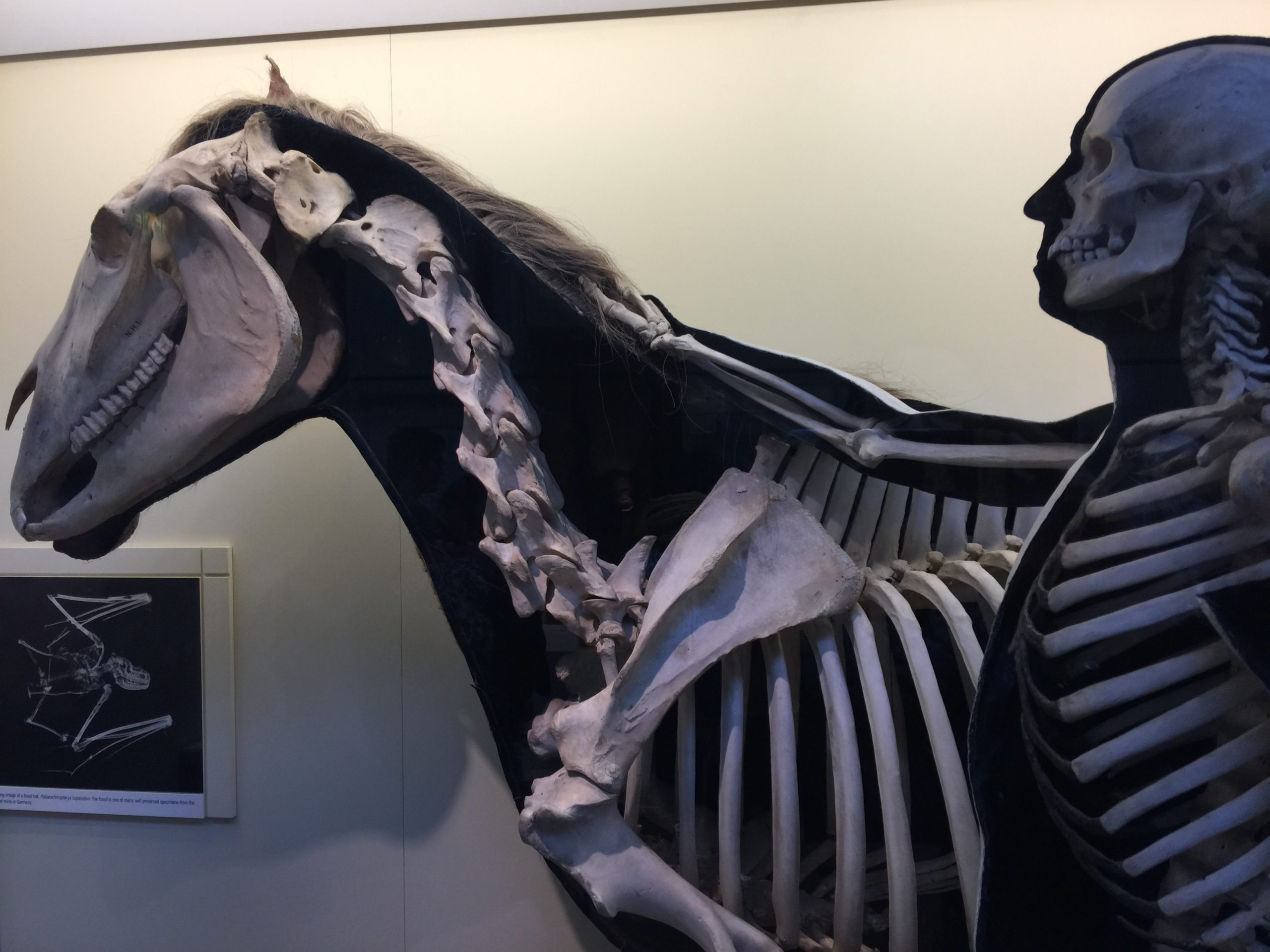 Generally, back pain affects the entire body. If you have ever experienced back pain, it can have a debilitating affect on your activity, from walking to sitting, standing and even lying down. If someone wants to make you do exercises if you’re in excruciating pain, that can be the worst thing for you.
Generally, back pain affects the entire body. If you have ever experienced back pain, it can have a debilitating affect on your activity, from walking to sitting, standing and even lying down. If someone wants to make you do exercises if you’re in excruciating pain, that can be the worst thing for you.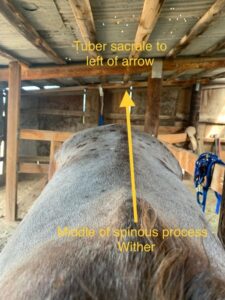
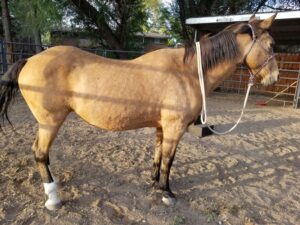
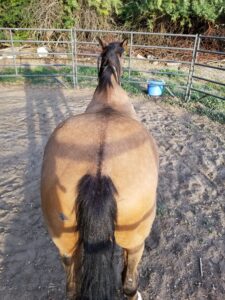
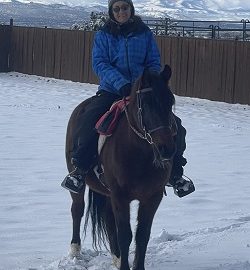
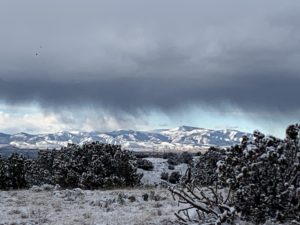
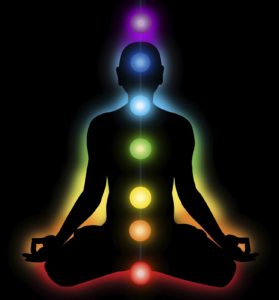
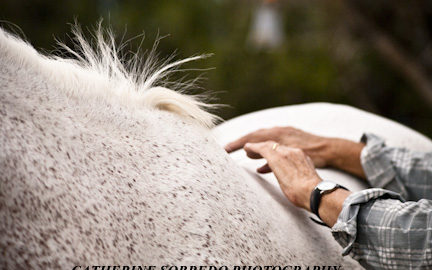
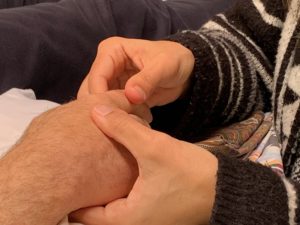 A healing journey is specific, non-specific, historic, full of layers and wondrous avenues of enlightenment. The layers that developed first – en utero, at birth – will be deepest in the body, and the last ones to heal. Perhaps we can go farther back than that – generations that will heal last, if at all in this lifetime. The healing journey is one of seeking to unravel those layers in the body’s time, as it has a time of its own. Seeking self-correction.
A healing journey is specific, non-specific, historic, full of layers and wondrous avenues of enlightenment. The layers that developed first – en utero, at birth – will be deepest in the body, and the last ones to heal. Perhaps we can go farther back than that – generations that will heal last, if at all in this lifetime. The healing journey is one of seeking to unravel those layers in the body’s time, as it has a time of its own. Seeking self-correction.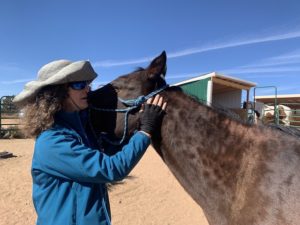 When I talk about injury, that injury could be internal or external, it could be musculoskeletal, visceral, neurological, circulatory, emotional, psychological, psychic…
When I talk about injury, that injury could be internal or external, it could be musculoskeletal, visceral, neurological, circulatory, emotional, psychological, psychic…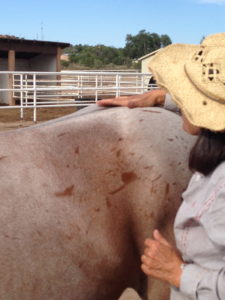 Horses demonstrate to us repetitive stress in so many ways. They are subjected to repetitive activities – training, carrying people with unaddressed repetitive stress and compensatory patterns, saddles, bridles, other tack, trailering, abuse, repetitive behaviors.
Horses demonstrate to us repetitive stress in so many ways. They are subjected to repetitive activities – training, carrying people with unaddressed repetitive stress and compensatory patterns, saddles, bridles, other tack, trailering, abuse, repetitive behaviors. to take place slowly, addressing each layer as an individual, peeling them back as the body is able to address them.
to take place slowly, addressing each layer as an individual, peeling them back as the body is able to address them. it is those things, the compensation is coming from a lot of places and the body wants to be addressed as a whole. Not only will it show its compensation, it will show its strengths – where it can move and where it is light and receptive.
it is those things, the compensation is coming from a lot of places and the body wants to be addressed as a whole. Not only will it show its compensation, it will show its strengths – where it can move and where it is light and receptive.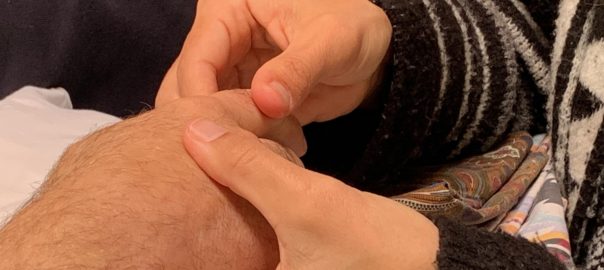


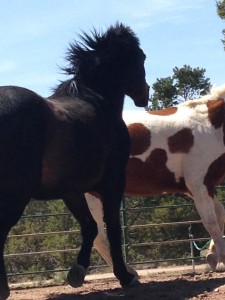 Horses have a herd mentality. Part of that is communicating without touching – flattening their ears or moving toward another horse across the pasture to get them to move, just twitching an ear in some cases. I only wish I had ears that talented. They also communicate with other species like birds. They can keep each other healthy and safe by moving the least among them. Their finely tuned energetic sense of what they need to have happen means everything.
Horses have a herd mentality. Part of that is communicating without touching – flattening their ears or moving toward another horse across the pasture to get them to move, just twitching an ear in some cases. I only wish I had ears that talented. They also communicate with other species like birds. They can keep each other healthy and safe by moving the least among them. Their finely tuned energetic sense of what they need to have happen means everything.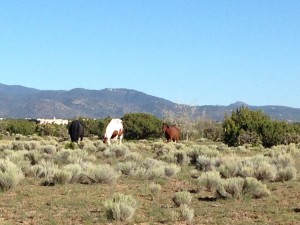
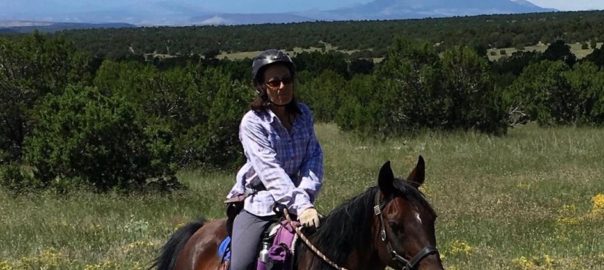


 All of us – horse and human – hold tension in our bodies and we also have areas that just don’t speak. We have places that don’t work as well as others. My right leg can get funky in the hip socket, for example. I could sit up there and worry about what a terrible rider I am and I shouldn’t ride because I’m not always symmetrical and blah blah blah, but if I focus on all the dysfunction, then I am missing what my body can do, and how it can support the areas that aren’t working quite so well. My horse has stuff going on in her hips also. I focus on the healing available in her body. And guess what? Even though she has that stuff, she is a beautiful mover. I sit on her, and I feel each part of me and her, and focus on the parts that work really well while holding an awareness of what I’d like to have shift.
All of us – horse and human – hold tension in our bodies and we also have areas that just don’t speak. We have places that don’t work as well as others. My right leg can get funky in the hip socket, for example. I could sit up there and worry about what a terrible rider I am and I shouldn’t ride because I’m not always symmetrical and blah blah blah, but if I focus on all the dysfunction, then I am missing what my body can do, and how it can support the areas that aren’t working quite so well. My horse has stuff going on in her hips also. I focus on the healing available in her body. And guess what? Even though she has that stuff, she is a beautiful mover. I sit on her, and I feel each part of me and her, and focus on the parts that work really well while holding an awareness of what I’d like to have shift. Certainly, work can be done on some of these issues independently of the horse/rider relationship, and I do that in many cases where a person may need individual table work ahead of a horse/rider session, or the horse needs to receive an entire session on his own. If someone has major back trouble, I’m going to work on that, and same with the horse. But once the bodies are free of great inhibition, we can bring them together and see where they can strengthen and enhance each other, and bring space into the relationship that may have been restricted before.
Certainly, work can be done on some of these issues independently of the horse/rider relationship, and I do that in many cases where a person may need individual table work ahead of a horse/rider session, or the horse needs to receive an entire session on his own. If someone has major back trouble, I’m going to work on that, and same with the horse. But once the bodies are free of great inhibition, we can bring them together and see where they can strengthen and enhance each other, and bring space into the relationship that may have been restricted before. ways of beginning this work. While grooming your horse you can feel along the spine for any irregularities. If you don’t know anatomy, it’s helpful to get a simple equine anatomy book – and a human one while you’re at it! Learn where the bones are. Everything else is related to or attached to the bones in some way, so it’s a great place to start.
ways of beginning this work. While grooming your horse you can feel along the spine for any irregularities. If you don’t know anatomy, it’s helpful to get a simple equine anatomy book – and a human one while you’re at it! Learn where the bones are. Everything else is related to or attached to the bones in some way, so it’s a great place to start.

 After that I may do a little bit of bodywork on areas I see are not working so well on my horse, and stretch out myself. You can apply your own exercises, such as qi gong, yoga, Feldenkrais, etc. and in Ortho-Bionomy© we have a lot of self-care exercises for people and ones you can do for your horse. Some of them I have adapted to use in the saddle as well.
After that I may do a little bit of bodywork on areas I see are not working so well on my horse, and stretch out myself. You can apply your own exercises, such as qi gong, yoga, Feldenkrais, etc. and in Ortho-Bionomy© we have a lot of self-care exercises for people and ones you can do for your horse. Some of them I have adapted to use in the saddle as well. Much thought has been given over centuries to how to ride efficiently and so as to bring out the best in the horse and rider. With the Mounted Body Balance™ approach, an older horse can move better than he or she ever has and so can her rider. Life isn’t static so we can’t guarantee that any of us are not going to have some physical challenges, but there is a lot we can solve and make more comfortable with this type of work. A horse may be able to help you with your body issues without impairing his/her own stride or balance. Of course, aging will limit what you can do but why not try to do what you love comfortably for as long as you can? As a physical therapist friend of mine says, “I’m here to help you be able to do what you love for longer.”
Much thought has been given over centuries to how to ride efficiently and so as to bring out the best in the horse and rider. With the Mounted Body Balance™ approach, an older horse can move better than he or she ever has and so can her rider. Life isn’t static so we can’t guarantee that any of us are not going to have some physical challenges, but there is a lot we can solve and make more comfortable with this type of work. A horse may be able to help you with your body issues without impairing his/her own stride or balance. Of course, aging will limit what you can do but why not try to do what you love comfortably for as long as you can? As a physical therapist friend of mine says, “I’m here to help you be able to do what you love for longer.”